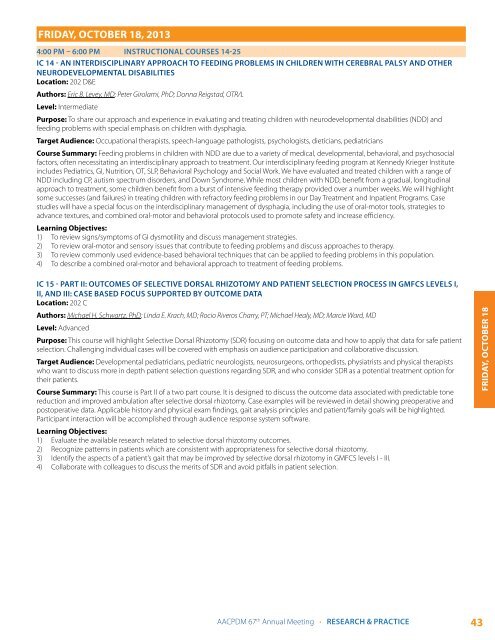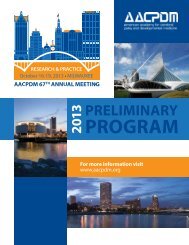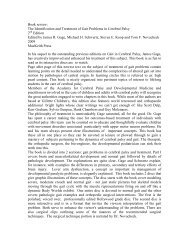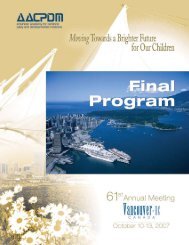ProgrAm - American Academy for Cerebral Palsy and ...
ProgrAm - American Academy for Cerebral Palsy and ...
ProgrAm - American Academy for Cerebral Palsy and ...
- No tags were found...
Create successful ePaper yourself
Turn your PDF publications into a flip-book with our unique Google optimized e-Paper software.
Friday, October 18, 20134:00 pm – 6:00 pm Instructional Courses 14-25IC 14 - AN INTERDISCIPLINARY APPROACH TO FEEDING PROBLEMS IN CHILDREN WITH CEREBRAL PALSY AND OTHERNEURODEVELOPMENTAL DISABILITIESLocation: 202 D&EAuthors: Eric B. Levey, MD; Peter Girolami, PhD; Donna Reigstad, OTR/LLevel: IntermediatePurpose: To share our approach <strong>and</strong> experience in evaluating <strong>and</strong> treating children with neurodevelopmental disabilities (NDD) <strong>and</strong>feeding problems with special emphasis on children with dysphagia.Target Audience: Occupational therapists, speech-language pathologists, psychologists, dieticians, pediatriciansCourse Summary: Feeding problems in children with NDD are due to a variety of medical, developmental, behavioral, <strong>and</strong> psychosocialfactors, often necessitating an interdisciplinary approach to treatment. Our interdisciplinary feeding program at Kennedy Krieger Instituteincludes Pediatrics, GI, Nutrition, OT, SLP, Behavioral Psychology <strong>and</strong> Social Work. We have evaluated <strong>and</strong> treated children with a range ofNDD including CP, autism spectrum disorders, <strong>and</strong> Down Syndrome. While most children with NDD, benefit from a gradual, longitudinalapproach to treatment, some children benefit from a burst of intensive feeding therapy provided over a number weeks. We will highlightsome successes (<strong>and</strong> failures) in treating children with refractory feeding problems in our Day Treatment <strong>and</strong> Inpatient Programs. Casestudies will have a special focus on the interdisciplinary management of dysphagia, including the use of oral-motor tools, strategies toadvance textures, <strong>and</strong> combined oral-motor <strong>and</strong> behavioral protocols used to promote safety <strong>and</strong> increase efficiency.Learning Objectives:1) To review signs/symptoms of GI dysmotility <strong>and</strong> discuss management strategies.2) To review oral-motor <strong>and</strong> sensory issues that contribute to feeding problems <strong>and</strong> discuss approaches to therapy.3) To review commonly used evidence-based behavioral techniques that can be applied to feeding problems in this population.4) To describe a combined oral-motor <strong>and</strong> behavioral approach to treatment of feeding problems.IC 15 - PART II: OUTCOMES OF SELECTIVE DORSAL RHIZOTOMY AND PATIENT SELECTION PROCESS IN GMFCS LEVELS I,II, AND III: CASE BASED FOCUS SUPPORTED BY OUTCOME DATALocation: 202 CAuthors: Michael H. Schwartz, PhD; Linda E. Krach, MD; Rocio Riveros Charry, PT; Michael Healy, MD; Marcie Ward, MDLevel: AdvancedPurpose: This course will highlight Selective Dorsal Rhizotomy (SDR) focusing on outcome data <strong>and</strong> how to apply that data <strong>for</strong> safe patientselection. Challenging individual cases will be covered with emphasis on audience participation <strong>and</strong> collaborative discussion.Target Audience: Developmental pediatricians, pediatric neurologists, neurosurgeons, orthopedists, physiatrists <strong>and</strong> physical therapistswho want to discuss more in depth patient selection questions regarding SDR, <strong>and</strong> who consider SDR as a potential treatment option <strong>for</strong>their patients.Course Summary: This course is Part II of a two part course. It is designed to discuss the outcome data associated with predictable tonereduction <strong>and</strong> improved ambulation after selective dorsal rhizotomy. Case examples will be reviewed in detail showing preoperative <strong>and</strong>postoperative data. Applicable history <strong>and</strong> physical exam findings, gait analysis principles <strong>and</strong> patient/family goals will be highlighted.Participant interaction will be accomplished through audience response system software.Learning Objectives:1) Evaluate the available research related to selective dorsal rhizotomy outcomes.2) Recognize patterns in patients which are consistent with appropriateness <strong>for</strong> selective dorsal rhizotomy.3) Identify the aspects of a patient’s gait that may be improved by selective dorsal rhizotomy in GMFCS levels I - III.4) Collaborate with colleagues to discuss the merits of SDR <strong>and</strong> avoid pitfalls in patient selection.FRIday, October 18AACPDM 67 th Annual Meeting • Research & Practice 43







